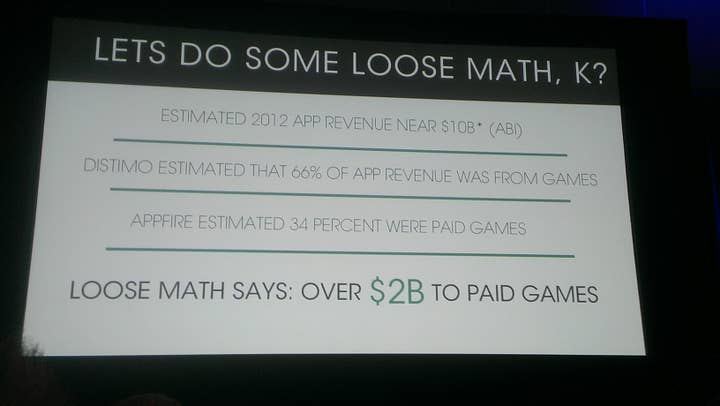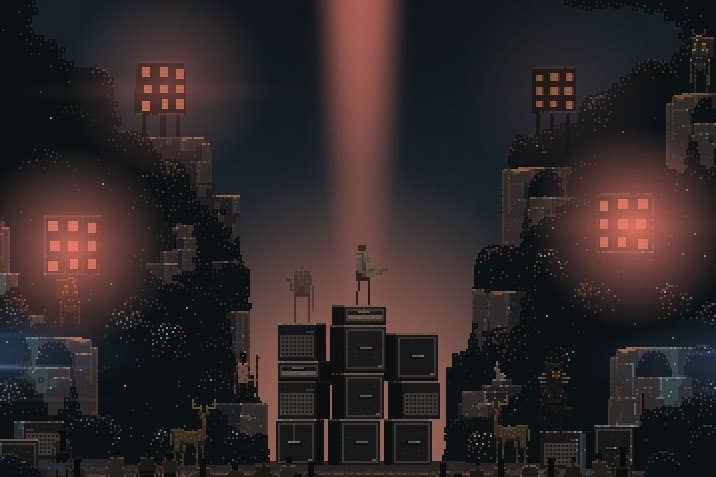There's still big money in paid apps
GDC 2013: Capy's Nathan Vella tries to get devs to move towards more paid apps
Everyone from larger publishers to small indies are moving towards free-to-play these days, but Capy co-founder and president Nathan Vella took to the stage at GDC 2013 today to tell developers why they should stick with paid apps. Vella's talk was aimed at smaller, unfunded studios trying to release their games in a crowded mobile market.
Vella started with statistics from AppFire and Distimo, showing that 66 percent of new apps in 2012 were free apps, illustrating the strength of the business model. Vella noted an almost 180 degree shift from the number of paid apps to free-to-play apps between June 2010 to June 2012. In 2010, everyone was aiming for the success of Angry Birds, but now developers are aiming for the success of Clash of Clans.
"Two years ago, we all wanted to have the next Angry Birds. But now the industry is specifically chasing Clash of Clans. They want to be the guys making $500,000 a day," said Vella.
The dialogue behind the death of paid apps reminded Vella of the industry calling for the death of other platforms.
"The dialogue reminds me so much of 'the death of's in the games industry, such as 'PC games are dead'. Then Steam happened. Humble Bundle happened. Minecraft happened, and all of a sudden no one's saying they're dead anymore. And now we're talking about how consoles are dead, but we've got a new cycle coming up, we still see billions of dollars coming from AAA, and we still see games on XBLA, PSN, and Wii U," said Vella. "So paid apps are dead, PC is dead, and consoles are dead. I'm going to have to call some bullshit."

Despite the fact that more money is being found in free-to-play, that doesn't mean that significant revenue can't be found in paid. Vella's rough math puts over $2 billion in revenue to paid games in 2012: total 2012 App Store revenue was near $10 billion, with Distimo estimating 66 percent of app revenue from games and 34 percent of those titles were paid games.
Ultimately, Vella stressed that paid app developers should not worry about the free-to-play space.
"Don't worry about the top-grossing charts, they are not a metric you should be following."
"Don't worry about the top-grossing charts, they are not a metric you should be following. They are not a metric that you should be caring about. There is still a massive amount of revenue to made, even outside of the Top 100 chart," he added. "Throw out the idea of building a game around a business model."
Paid games are built on trying to entice value customers early, while free-to-play tries to aim for the widest reach as possible. As both types of games progress beyond launch, that model switches sides as paid devs reach out to a wider audience and free-to-play devs try to firm up their hardcore audience. Understanding this will frame your strategy for development, build-up, launch, and post launch.
Vella's prime opportunities for paid apps are applicable to the Apple App Store, but the developer insisted that the lessons should apply equally to the Google Play Store. The first worthwhile opportunity comes in occupying spaces left open by larger publishers as they move to free-to-play business models. As the shift happens, smaller developers will find less friction in paid apps.
The shift by larger publishers leaves paid app charts open, which plays a huge role in getting featured on app stores. Store features are still a make-or-break proposition for paid app developers. Vella found that while free-to-play app charts are static - a problem he expects to get worse - paid app charts have more flexibility while still featuring perennial titles like Minecraft.
Vella also tackled the idea of paid user acquisition, a large problem in the mobile market. The movement of Asian publishers like Gree and DeNa into Western app stores raised the cost of user acquisition drastically, from 60 cents per user to more than 6 dollars per user. He explained that paid user acquisition doesn't exist at an appreciable level in paid games development.
According to Vella, there are a few areas where paid app development fits for a studio. The paid market is great a prototype/testing space, allowing developers to try out new ideas. Paid is also great for targeting niche genres or creating your own brand-new niche.
"[Paid games] need to celebrate the concept over the scale. You're going to be making these games for a low amount of money and because they're interesting, unique, fun, crazy, they are going to get some traction. They are going to get some coverage. They are going to be a game that someone will talk about," said Vella.
Mainstream genres are prime for paid, as free-to-play has very specific genre effectiveness. Certain genres don't work well for free-to-play development, like adventure games. Transitioning hardcore console games to mobile platforms are also a stand-out space for paid apps, though developers should be prepared to tailor titles to new platforms. Paid development is also the last bastion for narrative-driven games, like Telltale's The Walking Dead.

Vella then outlined some of the best practices of promoting your paid apps to the market. Small developers need to be cognizant of promoting to both fans and store holders (Apple/Google) in a 50/50 split. Great promoting towards fans can ignite the attention of editorial teams at Apple and Google, but developers should think about how their game shows off hardware.
Capybara's process for paid game development focuses on making a great finished product, as paid games tend to rely on the initial audience. Being critical of your game and playtesting are key. Hype is also a large part of the process. Vella used the example of Vlambeer's Ridiculous Fishing, which had a great story it used to sell the game to players and platform holders. Being cloned and then bouncing back to create an even better product helped cement the title in the mind of fans.
"The argument that sales depreciate games is complete bullshit."
Developers should start approaching App Store and Google Play like Valve approaches Steam, Vella explained. Steam uses sales to motivate buyers. He also cautioned developers to move away from the 99 cent price point.
"In my opinion, Steam is the most viable, effective paid app marketplace in existence right now. Even more effective than [the App Store] and Google Play," he said. "The argument that sales depreciate games is complete bullshit. All it's doing is convincing more people to buy your game that never would've bought your game before."
"There's a real shift away from 99 cents for all but the most ultra-casual, super-mass-market-focused products. It's leveraging the real strength of paid apps, because it's generating the most revenue possible from the most interested people. You're asking the people who are most interested to pay you more."

Vella emphasized that developers should localize, port, and update their games, making sure that apps work on new and upcoming hardware. Finally, paid development means if your game doesn't work, it's best to move on. Games are not a service with paid apps; developers should support titles, but creative time is better spent creating something new than polishing an existing game.

